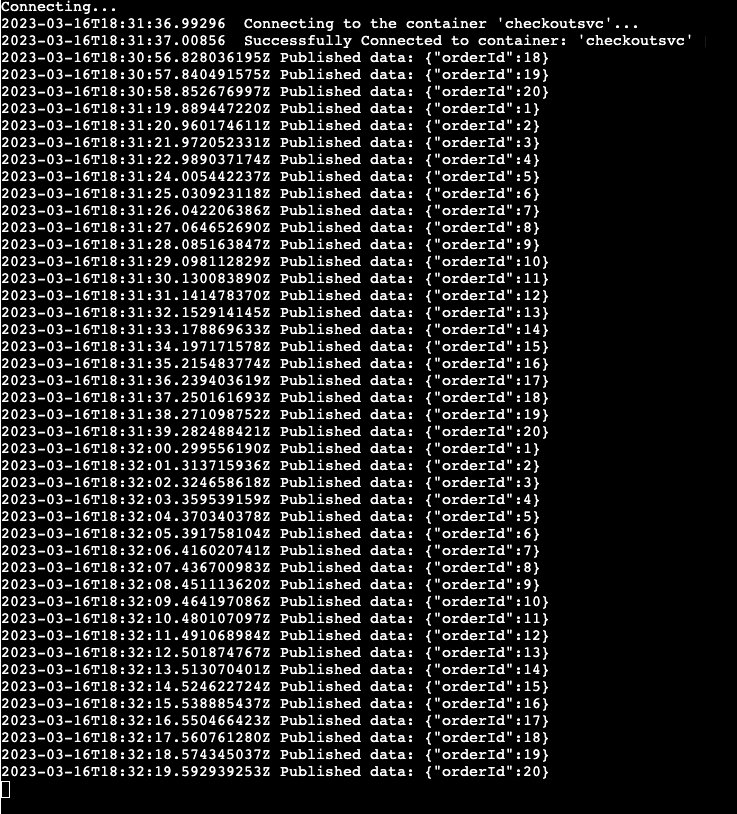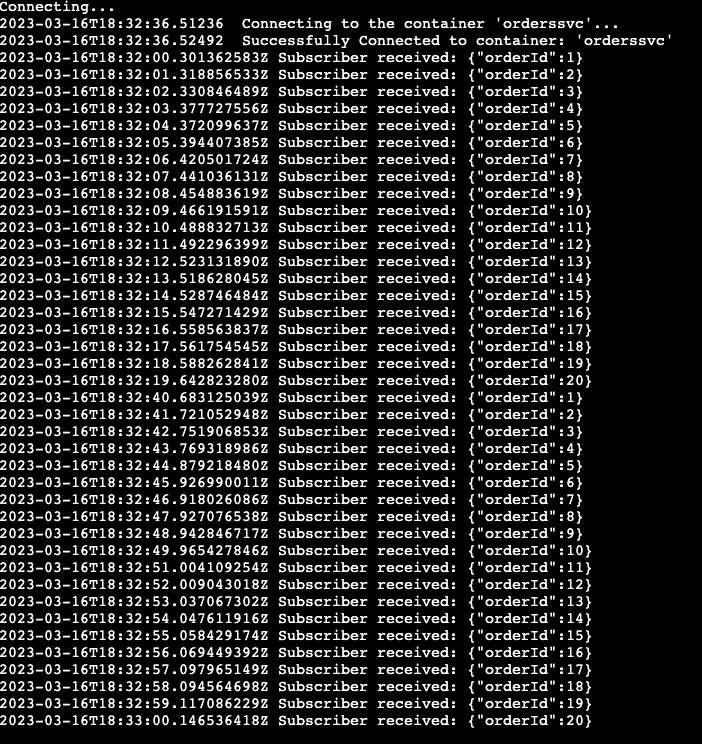教學課程:使用 Dapr 發佈和訂閱的微服務通訊
在此教學課程中,您會建立發行者和訂閱者微服務,以利用 Dapr pub/sub API 來使用事件驅動架構的訊息進行通訊。 您將會:
- 建立發行者微服務和訂閱者微服務,以利用 Dapr pub/sub API 來使用事件驅動架構的訊息進行通訊。
- 透過 Azure Developer CLI 搭配提供的 Bicep 將應用程式部署至 Azure 容器應用程式。
範例 pub/sub 專案包含:
- 產生特定主題訊息的訊息產生器
checkout服務 (發行者)。 - 接聽特定主題
checkout服務訊息的order-processor服務 (訂閱者)。

必要條件
- 安裝 Azure Developer CLI
- 安裝和 init Dapr
- Docker Desktop
- 安裝 Git
在本端執行 Node.js 應用程式
將應用程式部署至 Azure 容器應用程式之前,請先使用 Dapr 和 Azure 服務匯流排在本機執行 order-processor 和 checkout 服務。
準備專案
將範例應用程式複製到本機電腦。
git clone https://github.com/Azure-Samples/pubsub-dapr-nodejs-servicebus.git瀏覽至範例的根目錄。
cd pubsub-dapr-nodejs-servicebus
使用 Dapr CLI 執行應用程式
首先,執行 order-processor 訂閱者服務。
從範例的根目錄,請將目錄變更為
order-processor。cd order-processor安裝相依性。
npm install執行
order-processor服務。dapr run --app-port 5001 --app-id order-processing --app-protocol http --dapr-http-port 3501 --resources-path ../components -- npm run start在新的終端機視窗中,從範例的根目錄瀏覽至
checkout發行者服務。cd checkout安裝相依性。
npm install執行
checkout服務。dapr run --app-id checkout --app-protocol http --resources-path ../components -- npm run start預期的輸出
在這兩個終端機中,
checkout服務會在結束前發佈order-processor服務所接收的 10 則訊息。checkout輸出:== APP == Published data: {"orderId":1} == APP == Published data: {"orderId":2} == APP == Published data: {"orderId":3} == APP == Published data: {"orderId":4} == APP == Published data: {"orderId":5} == APP == Published data: {"orderId":6} == APP == Published data: {"orderId":7} == APP == Published data: {"orderId":8} == APP == Published data: {"orderId":9} == APP == Published data: {"orderId":10}order-processor輸出:== APP == Subscriber received: {"orderId":1} == APP == Subscriber received: {"orderId":2} == APP == Subscriber received: {"orderId":3} == APP == Subscriber received: {"orderId":4} == APP == Subscriber received: {"orderId":5} == APP == Subscriber received: {"orderId":6} == APP == Subscriber received: {"orderId":7} == APP == Subscriber received: {"orderId":8} == APP == Subscriber received: {"orderId":9} == APP == Subscriber received: {"orderId":10}執行下列命令,確定這兩個應用程式都已停止。 在簽出終端機中:
dapr stop --app-id checkout在 order-processor 終端機中:
dapr stop --app-id order-processor
使用 Azure Developer CLI 部署應用程式範本
使用 azd 將應用程式部署至 Azure 容器應用程式。
準備專案
在新的終端機視窗中,瀏覽至範例的根目錄。
cd pubsub-dapr-nodejs-servicebus
使用 Azure Developer CLI 佈建和部署
執行
azd init來初始化專案。azd init在終端機出現提示時,請提供下列參數。
參數 描述 環境名稱 建立以保存所有 Azure 資源的資源群組前綴。 Azure 位置 您資源的 Azure 位置。 Azure 訂用帳戶 您資源的 Azure 訂閱。 執行
azd up以使用單一命令佈建基礎結構,並將應用程式部署至 Azure 容器應用程式。azd up此程序需要一些時間才會完成。 當
azd up命令完成時,CLI 輸出會顯示兩個 Azure 入口網站連結,以監視部署進度。 輸出也會示範如何azd up:- 使用
azd provision透過./infra目錄提供的 Bicep 檔案,建立和設定所有必要的 Azure 資源。 一旦透過 Azure Developer CLI 佈建後,便可以透過 Azure 入口網站存取這些資源。 佈建 Azure 資源的檔案包含下列項目:main.parameters.jsonmain.bicep- 依功能組織的
app資源目錄 - 包含
azd範本所使用的 Bicep 模組的core參考程式庫
- 使用
azd deploy部署程式碼
預期的輸出
Initializing a new project (azd init) Provisioning Azure resources (azd provision) Provisioning Azure resources can take some time You can view detailed progress in the Azure Portal: https://portal.azure.com (✓) Done: Resource group: resource-group-name (✓) Done: Application Insights: app-insights-name (✓) Done: Portal dashboard: portal-dashboard-name (✓) Done: Log Analytics workspace: log-analytics-name (✓) Done: Key vault: key-vault-name (✓) Done: Container Apps Environment: ca-env-name (✓) Done: Container App: ca-checkout-name (✓) Done: Container App: ca-orders-name Deploying services (azd deploy) (✓) Done: Deploying service checkout (✓) Done: Deploying service orders - Endpoint: https://ca-orders-name.endpoint.region.azurecontainerapps.io/ SUCCESS: Your Azure app has been deployed! You can view the resources created under the resource group resource-group-name in Azure Portal: https://portal.azure.com/#@/resource/subscriptions/subscription-id/resourceGroups/resource-group-name/overview- 使用
確認成功部署
在 Azure 入口網站中,驗證 checkout 服務正在將訊息發佈至 Azure 服務匯流排主題。
從終端機輸出複製
checkout容器應用程式名稱。登入 Azure 入口網站,然後依名稱搜尋容器應用程式資源。
在「容器應用程式」儀表板中,選取「監視>記錄資料流」。
![瀏覽至 Azure 入口網站中 [記錄串流] 頁面的螢幕擷取畫面。](media/microservices-dapr-azd/log-streams-menu.png)
確認
checkout容器正在記錄的輸出與稍早的終端機相同。
請對
order-processor服務執行相同動作。
發生什麼事?
azd up 命令成功完成時:
- Azure Developer CLI 已將範例專案
./infra目錄中所參考的 Azure 資源佈建到您指定的 Azure 訂閱。 您現在可以透過 Azure 入口網站檢視這些 Azure 資源。 - 應用程式會部署至 Azure 容器應用程式。 您可以從入口網站瀏覽至全部的功能應用程式。
在本機執行 Python 應用程式
將應用程式部署至 Azure 容器應用程式之前,請先使用 Dapr 和 Azure 服務匯流排在本機執行 order-processor 和 checkout 服務。
準備專案
將範例應用程式複製到本機電腦。
git clone https://github.com/Azure-Samples/pubsub-dapr-python-servicebus.git瀏覽至範例的根目錄。
cd pubsub-dapr-python-servicebus
使用 Dapr CLI 執行應用程式
首先,執行 order-processor 訂閱者服務。
從範例的根目錄,請將目錄變更為
order-processor。cd order-processor安裝相依性。
pip3 install -r requirements.txt執行
order-processor服務。
在新的終端機視窗中,從範例的根目錄瀏覽至
checkout發行者服務。cd checkout安裝相依性。
pip3 install -r requirements.txt執行
checkout服務。
預期的輸出
在這兩個終端機中,checkout 服務會在結束前發佈 order-processor 服務所接收的 10 則訊息。
checkout 輸出:
== APP == Published data: {"orderId":1}
== APP == Published data: {"orderId":2}
== APP == Published data: {"orderId":3}
== APP == Published data: {"orderId":4}
== APP == Published data: {"orderId":5}
== APP == Published data: {"orderId":6}
== APP == Published data: {"orderId":7}
== APP == Published data: {"orderId":8}
== APP == Published data: {"orderId":9}
== APP == Published data: {"orderId":10}
order-processor 輸出:
== APP == Subscriber received: {"orderId":1}
== APP == Subscriber received: {"orderId":2}
== APP == Subscriber received: {"orderId":3}
== APP == Subscriber received: {"orderId":4}
== APP == Subscriber received: {"orderId":5}
== APP == Subscriber received: {"orderId":6}
== APP == Subscriber received: {"orderId":7}
== APP == Subscriber received: {"orderId":8}
== APP == Subscriber received: {"orderId":9}
== APP == Subscriber received: {"orderId":10}
執行下列命令,確定這兩個應用程式都已停止。 在簽出終端機中:
dapr stop --app-id checkout在 order-processor 終端機中:
dapr stop --app-id order-processor
使用 Azure Developer CLI 部署應用程式範本
使用 azd 將應用程式部署至 Azure 容器應用程式。
準備專案
在新的終端機視窗中,瀏覽至範例的根目錄。
cd pubsub-dapr-python-servicebus
使用 Azure Developer CLI 佈建和部署
執行
azd init來初始化專案。azd init在終端機出現提示時,請提供下列參數。
參數 描述 環境名稱 建立以保存所有 Azure 資源的資源群組前綴。 Azure 位置 您資源的 Azure 位置。 Azure 訂用帳戶 您資源的 Azure 訂閱。 執行
azd up以使用單一命令佈建基礎結構,並將應用程式部署至 Azure 容器應用程式。azd up此程序需要一些時間才會完成。 當
azd up命令完成時,CLI 輸出會顯示兩個 Azure 入口網站連結,以監視部署進度。 輸出也會示範如何azd up:- 使用
azd provision透過./infra目錄提供的 Bicep 檔案,建立和設定所有必要的 Azure 資源。 一旦透過 Azure Developer CLI 佈建後,便可以透過 Azure 入口網站存取這些資源。 佈建 Azure 資源的檔案包含下列項目:main.parameters.jsonmain.bicep- 依功能組織的
app資源目錄 - 包含
azd範本所使用的 Bicep 模組的core參考程式庫
- 使用
azd deploy部署程式碼
預期的輸出
Initializing a new project (azd init) Provisioning Azure resources (azd provision) Provisioning Azure resources can take some time You can view detailed progress in the Azure Portal: https://portal.azure.com (✓) Done: Resource group: resource-group-name (✓) Done: Application Insights: app-insights-name (✓) Done: Portal dashboard: portal-dashboard-name (✓) Done: Log Analytics workspace: log-analytics-name (✓) Done: Key vault: key-vault-name (✓) Done: Container Apps Environment: ca-env-name (✓) Done: Container App: ca-checkout-name (✓) Done: Container App: ca-orders-name Deploying services (azd deploy) (✓) Done: Deploying service checkout (✓) Done: Deploying service orders - Endpoint: https://ca-orders-name.endpoint.region.azurecontainerapps.io/ SUCCESS: Your Azure app has been deployed! You can view the resources created under the resource group resource-group-name in Azure Portal: https://portal.azure.com/#@/resource/subscriptions/subscription-id/resourceGroups/resource-group-name/overview- 使用
確認成功部署
在 Azure 入口網站中,驗證 checkout 服務正在將訊息發佈至 Azure 服務匯流排主題。
從終端機輸出複製
checkout容器應用程式名稱。登入 Azure 入口網站,然後依名稱搜尋容器應用程式資源。
在「容器應用程式」儀表板中,選取「監視>記錄資料流」。
![瀏覽至 Azure 入口網站中 [記錄串流] 頁面的螢幕擷取畫面。](media/microservices-dapr-azd/log-streams-menu.png)
確認
checkout容器正在記錄的輸出與稍早的終端機相同。
請對
order-processor服務執行相同動作。
發生什麼事?
azd up 命令成功完成時:
- Azure Developer CLI 已將範例專案
./infra目錄中所參考的 Azure 資源佈建到您指定的 Azure 訂閱。 您現在可以透過 Azure 入口網站檢視這些 Azure 資源。 - 應用程式會部署至 Azure 容器應用程式。 您可以從入口網站瀏覽至全部的功能應用程式。
在本機執行 .NET 應用程式
將應用程式部署至 Azure 容器應用程式之前,請先使用 Dapr 和 Azure 服務匯流排在本機執行 order-processor 和 checkout 服務。
準備專案
將範例應用程式複製到本機電腦。
git clone https://github.com/Azure-Samples/pubsub-dapr-csharp-servicebus.git瀏覽至範例的根目錄。
cd pubsub-dapr-csharp-servicebus
使用 Dapr CLI 執行應用程式
首先,執行 order-processor 訂閱者服務
從範例的根目錄,請將目錄變更為
order-processor。cd order-processor安裝相依性。
dotnet build執行
order-processor服務。dapr run --app-id order-processor --resources-path ../components/ --app-port 7001 -- dotnet run --project .在新的終端機視窗中,從範例的根目錄瀏覽至
checkout發行者服務。cd checkout安裝相依性。
dotnet build執行
checkout服務。dapr run --app-id checkout --resources-path ../components/ -- dotnet run --project .預期的輸出
在這兩個終端機中,
checkout服務會在結束前發佈order-processor服務所接收的 10 則訊息。checkout輸出:== APP == Published data: {"orderId":1} == APP == Published data: {"orderId":2} == APP == Published data: {"orderId":3} == APP == Published data: {"orderId":4} == APP == Published data: {"orderId":5} == APP == Published data: {"orderId":6} == APP == Published data: {"orderId":7} == APP == Published data: {"orderId":8} == APP == Published data: {"orderId":9} == APP == Published data: {"orderId":10}order-processor輸出:== APP == Subscriber received: {"orderId":1} == APP == Subscriber received: {"orderId":2} == APP == Subscriber received: {"orderId":3} == APP == Subscriber received: {"orderId":4} == APP == Subscriber received: {"orderId":5} == APP == Subscriber received: {"orderId":6} == APP == Subscriber received: {"orderId":7} == APP == Subscriber received: {"orderId":8} == APP == Subscriber received: {"orderId":9} == APP == Subscriber received: {"orderId":10}執行下列命令,確定這兩個應用程式都已停止。 在簽出終端機中。
dapr stop --app-id checkout在 order-processor 終端機中:
dapr stop --app-id order-processor
使用 Azure Developer CLI 部署應用程式範本
使用 azd 將應用程式部署至 Azure 容器應用程式。
準備專案
在新的終端機視窗中,瀏覽至範例的根目錄。
cd pubsub-dapr-csharp-servicebus
使用 Azure Developer CLI 佈建和部署
執行
azd init來初始化專案。azd init在終端機出現提示時,請提供下列參數。
參數 描述 環境名稱 建立以保存所有 Azure 資源的資源群組前綴。 Azure 位置 您資源的 Azure 位置。 Azure 訂用帳戶 您資源的 Azure 訂閱。 執行
azd up以使用單一命令佈建基礎結構,並將應用程式部署至 Azure 容器應用程式。azd up此程序需要一些時間才會完成。 當
azd up命令完成時,CLI 輸出會顯示兩個 Azure 入口網站連結,以監視部署進度。 輸出也會示範如何azd up:- 使用
azd provision透過./infra目錄提供的 Bicep 檔案,建立和設定所有必要的 Azure 資源。 一旦透過 Azure Developer CLI 佈建後,便可以透過 Azure 入口網站存取這些資源。 佈建 Azure 資源的檔案包含下列項目:main.parameters.jsonmain.bicep- 依功能組織的
app資源目錄 - 包含
azd範本所使用的 Bicep 模組的core參考程式庫
- 使用
azd deploy部署程式碼
預期的輸出
Initializing a new project (azd init) Provisioning Azure resources (azd provision) Provisioning Azure resources can take some time You can view detailed progress in the Azure Portal: https://portal.azure.com (✓) Done: Resource group: resource-group-name (✓) Done: Application Insights: app-insights-name (✓) Done: Portal dashboard: portal-dashboard-name (✓) Done: Log Analytics workspace: log-analytics-name (✓) Done: Key vault: key-vault-name (✓) Done: Container Apps Environment: ca-env-name (✓) Done: Container App: ca-checkout-name (✓) Done: Container App: ca-orders-name Deploying services (azd deploy) (✓) Done: Deploying service checkout (✓) Done: Deploying service orders - Endpoint: https://ca-orders-name.endpoint.region.azurecontainerapps.io/ SUCCESS: Your Azure app has been deployed! You can view the resources created under the resource group resource-group-name in Azure Portal: https://portal.azure.com/#@/resource/subscriptions/subscription-id/resourceGroups/resource-group-name/overview- 使用
確認成功部署
在 Azure 入口網站中,驗證 checkout 服務正在將訊息發佈至 Azure 服務匯流排主題。
從終端機輸出複製
checkout容器應用程式名稱。登入 Azure 入口網站,然後依名稱搜尋容器應用程式資源。
在「容器應用程式」儀表板中,選取「監視>記錄資料流」。
![瀏覽至 Azure 入口網站中 [記錄串流] 頁面的螢幕擷取畫面。](media/microservices-dapr-azd/log-streams-menu.png)
確認
checkout容器正在記錄的輸出與稍早的終端機相同。
請對
order-processor服務執行相同動作。
發生什麼事?
azd up 命令成功完成時:
- Azure Developer CLI 已將範例專案
./infra目錄中所參考的 Azure 資源佈建到您指定的 Azure 訂閱。 您現在可以透過 Azure 入口網站檢視這些 Azure 資源。 - 應用程式會部署至 Azure 容器應用程式。 您可以從入口網站瀏覽至全部的功能應用程式。
清除資源
若您不打算繼續使用此應用程式,請刪除使用下列命令佈建的 Azure 資源:
azd down